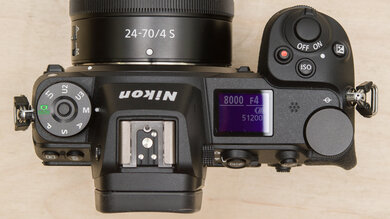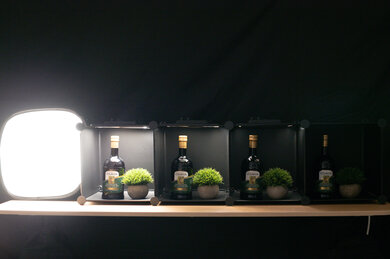The Nikon Z 6 is a full-frame mirrorless camera with a premium, well-built design. It has excellent image quality, so your photos appear sharp and detailed. Also, its excellent photo autofocus feature helps keep moving subjects in focus in your pictures. This camera also has decent video quality in 4k and FHD, but videos aren't as sharp as those recorded with some other cameras we've tested. Also, its bulky build may not make it ideal to bring with you on the go.
Our Verdict
The Nikon Z6 is good for travel photography. It has excellent image quality, so your photos are sharp and detailed, and its excellent autofocus feature helps keep moving subjects in focus. This camera is well-built and easy to use but is a bit heavy.
-
Well-built design.
-
Amazing image quality.
-
Excellent photo autofocus performance.
-
Not very portable.
The Nikon Z6 is great for landscape photography. This well-built camera is easy to use, and its screen is readable even if you're shooting in bright sunlight. It also has amazing image quality, so photos look detailed and sharp, with excellent dynamic range to bring out more detail in high-contrast landscapes. Unfortunately, this camera is a bit heavy, so it isn't the most portable.
-
Well-built design.
-
Amazing image quality.
-
Not very portable.
The Nikon Z6 is great for sport and wildlife photography. Thanks to its high continuous shooting speed, you can take bursts of pictures that help you get a clear shot of fast-moving subjects. Also, it does an incredible job tracking fast-moving subjects thanks to its excellent autofocus system. It has amazing image quality and handles noise superbly well, too.
-
Amazing image quality.
-
Excellent photo autofocus performance.
-
Not very portable.
The Nikon Z 6 has excellent RAW image quality. It has amazing dynamic range to capture more detail in the range of shadows and highlights. Images also appear sharp and detailed, even when cropping in. Finally, it does a great job of managing noise in low light, with very clean files in situations where you have to bump up your ISO.
-
Excellent dynamic range.
-
Great noise performance in low light.
The Nikon Z6 is okay for vlogging. It isn't very portable, and its tilting screen can't be flipped to point forward so you can see yourself while you record. It has good video quality in 4K and FHD, but but the camera does exhibit a noticeable rolling shutter effect when panning side to side. Fortunately, its video stabilization helps provide stable footage even if you're walking while filming.
-
Very good video stabilization performance.
-
Not very portable.
The Nikon Z6 is great for studio video. It has good video quality in both 4k and FHD. Also, it has lots of inputs for commonly used accessories like a microphone and headphones. Thanks to its face detection feature, its autofocus does an incredible job focusing on the faces of moving people in both 4k and FHD, but it struggles a little more to stay focused on moving objects.
-
Face detection feature.
-
Lots of inputs for headphones and other accessories.
-
Video autofocus can struggle to keep focus on moving objects.
The Nikon Z6 is inadequate for action video. This camera isn't very portable and isn't meant to be mounted on a helmet. It isn't waterproof, either. On the upside, it has good 4k and FHD video quality and can provide stable footage even if you're moving a lot while filming.
-
Very good video stabilization performance.
-
Not very portable.
-
No water resistance.
- 7.9 Travel Photography
- 8.4 Landscape Photography
- 8.2 Sport & Wildlife Photography
- 8.6 Raw Photo Performance
- 6.5 Vlogging
- 8.3 Studio Video
- 5.3 Action Video
Changelog
- Updated Jan 29, 2024: Added text to the 'Raw Photo Performance' verdict box and updated existing verdict boxes for clarity and accuracy.
- Updated Jan 29, 2024: Converted to Test Bench 0.12.1.
- Updated Dec 14, 2022: Converted to Test Bench 0.12.
- Updated Nov 21, 2022: Converted to Test Bench 0.11.
- Updated Oct 03, 2022: Converted to Test Bench 0.10.
Differences Between Sizes And Variants
The Nikon Z6 comes in 'Black'. We purchased this camera with the Nikkor Z 24-70mm f/4 S lens, and you can see the label for the model we tested here.
This camera is also compatible with other Nikkor Z lenses, and you can also purchase it without a lens at all. However, we haven't tested its performance in any other configuration.
If you come across another version, let us know in the discussions so we can update our review.
Compared To Other Cameras
The Nikon Z 6 is a bit better overall than the Nikon Z 5, but the Z 5 still offers a lot of value for those just getting into full-frame photography. The Z 5 is Nikon's entry-level full-frame camera, while the Z 6 is a higher-end enthusiast model. Because of that, the Z 6 has a faster continuous shooting speed, can shoot 4k video without a crop and more frame rate options, and has a CFexpress card slot. However, it does have a shorter battery life than the Z 5.
The Sony α7 III and the Nikon Z 6 are both excellent full-frame cameras. The Nikon is better built, with a weather-sealed body, has better ergonomics, and has a higher-resolution EVF. The Sony has a better battery life, a faster max burst rate, and a more established lens ecosystem.
If you're looking to upgrade from the Nikon Z 6, the Nikon Z 6III is well worth considering, particularly if you're a hybrid or video shooter. It has substantial improvements over the older model, including a new partially stacked sensor, a better processor, as well as an updated autofocus system and IBIS system. It significantly outclasses the Z 6 in video features, with internal Log recording and internal RAW video in 6k at up to 60p. However, if you're primarily interested in photography, you'll likely still be satisfied with the Z 6, unless you need the faster burst rates offered by the Z 6III.
The Nikon Z 6 is a higher-end model than the entry-level Nikon Z 50, so it's better suited to more advanced photographers. Its full-frame sensor captures a wider dynamic range and has better noise handling in low light. Overall, it feels more sturdy and premium, with a higher-resolution screen and viewfinder. On the flip side, the Z 50 is more portable, with simpler controls and features that are more suited to novice shooters.
The Nikon Z f is better overall than the Nikon Z 6, with a newer, more effective autofocus system and better video specs. However, some people may prefer the more traditional ergonomics of the Z 6.
The Canon EOS R6 and the Nikon Z 6 are both great full-frame cameras, but the Canon is a bit more well-rounded. It has more advanced video features, like internal 10-bit Log recording and 4k recording at up to 60 fps. The Canon also has a better overall autofocus tracking feature. Otherwise, they're pretty evenly matched, and you might prefer one's ergonomics, user interface, and lens ecosystem over the other's.
The Nikon Z 6 and the Canon EOS R8 are both great full-frame models with different advantages. The Nikon is a higher-end model, so it feels better built and has a higher-resolution viewfinder, better ergonomics, and in-body image stabilization. That said, the Canon is more portable and offers better video features.
Test Results
- Magnesium alloy body, mix of rubberized and hard plastic exterior feel solid
- Dials and buttons are sturdy and offer good physical feedback
- Battery and SD card compartments covered by hinged doors
- Additional mini OLED display beside the thumb command dial
- Input and output compartments are covered by rubber flaps
- Lots of room between body and lens; thumb can rest out of the way of the screen without accidentally pressing any buttons
- Viewfinder cover made of comfortable rubber
- Textured hand grip is comfortable and grippy
- Camera is a bit heavy
- Menu system easy to navigate using the touchscreen
- Using the shortcut/quick settings menu lets you access frequently used features and functions
- Nikon SnapBridge app can be used to operate some of the camera's functions through your phone
- Guide mode helps explain settings and features
- A few functions are hard to find, like video assistants and focus assist
Comments
Nikon Z 6: Main Discussion
Let us know why you want us to review the product here, or encourage others to vote for this product.
- 21010
Hi, in the meantime i’ve noticed that the selected bit depth affects FPS in extended H, setting it to 12 bit gives higher FPS than setting it to 14 bit, so that might be where that discrepency comes from, but that should only affect RAW images, and the test says jpg
Hey IIMKGII,
Thank you for your patience while I looked into this.
Regarding the shooting speed, it’s quite possible that the camera can shoot at 12 fps. As you know, many variables can affect shooting speed, and different settings and conditions during testing could explain the discrepancy. Unfortunately, we no longer have the camera in our inventory to retest the shooting speed and update our test results.
As for the XQD card compatibility, you are correct. Our current methodology doesn’t list every compatible card. I appreciate you bringing this to our attention. I will relay your feedback to our R&D department, and we will add this to our list of suggested improvements for future test bench updates.
Thank you again for your valuable comments. If you have any other questions, comments, or feedback in the future, please don’t hesitate to reach out. We truly appreciate your insights and support.
- 21010
Hi, in the meantime i’ve noticed that the selected bit depth affects FPS in extended H, setting it to 12 bit gives higher FPS than setting it to 14 bit, so that might be where that discrepency comes from, but that should only affect RAW images, and the test says jpg
Edited 9 months ago: added additional info i forgot to include - 21010
Have this camera myself and when comparing it to a different model i noticed some of the infos are wrong. I haven’t tested Silent Shooting Continuos, but i have tested High Speed Continuous myself and i got values between 12-13fps, so the 8fps mentioned here is wrong, maybe you guys set the camera to Continuos H instead of Continuos H (Extended). Second thing i noticed is that you write that the camera has a CFExpress Card Slot 1, not entirely correct, it takes in both CFExpress Type B and XQD Cards
Hey IIMKGII! Thank you for your detailed feedback! I appreciate you taking the time to share your observations. I’ll look into the discrepancies you’ve mentioned and get back to you with an update next week.
- 21010
Have this camera myself and when comparing it to a different model i noticed some of the infos are wrong. I haven’t tested Silent Shooting Continuos, but i have tested High Speed Continuous myself and i got values between 12-13fps, so the 8fps mentioned here is wrong, maybe you guys set the camera to Continuos H instead of Continuos H (Extended). Second thing i noticed is that you write that the camera has a CFExpress Card Slot 1, not entirely correct, it takes in both CFExpress Type B and XQD Cards
Update: Added text to the ‘Raw Photo Performance’ verdict box and updated existing verdict boxes for clarity and accuracy.































































